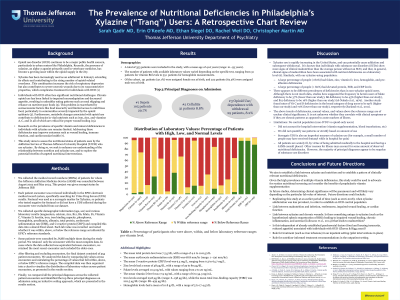Substance Use and Related Disorders
(175) The Prevalence of Nutritional Deficiencies in Philadelphia's Xylazine ("Tranq") Users: A Retrospective Chart Review


Sarah Qadir, MD (she/her/hers)
Resident Physician
Thomas Jefferson University Hospital
Philadelphia, Pennsylvania
Rachel Weil, DO
Resident Physician
Thomas Jefferson University Hospital
Philadelphia, Pennsylvania
Ethan R. Siegel, DO
Resident Physician
Thomas Jefferson University Hospital
Philadelphia, Pennsylvania
Erin O'Keefe, MD
Resident Physician
Thomas Jefferson University Hospital
Philadelphia, Pennsylvania- CM
Christopher R. Martin, MD
Clinical Assistant Professor
Thomas Jefferson University Hospital
Philadelphia, Pennsylvania
Presenting Author(s)
Co-Author(s)
Background/Significance: Xylazine, a centrally acting alpha-2 agonist initially used as an animal tranquilizer, is the most common contaminant in Philadelphia’s drug supply, found in 90% of street opioid samples (Bettigole & Texiera da Silva, 2022). The Jefferson Addiction Medicine Service (JAMS) at Thomas Jefferson University Hospital (TJUH) has observed that patients using xylazine often present to the hospital with non-healing wounds and deficiencies of iron and ferritin, which are involved in the wound healing process. Many of these patients are also malnourished. Currently, there is no literature establishing correlations between xylazine use and vitamin deficiencies.
Methods: This is a retrospective chart review of individuals medically admitted at TJUH who had specialty consults placed to the JAMS service from January 2020 to March 2024. Inclusion criteria includes a chart history of fentanyl use disorder (a surrogate for xylazine use) and a urine drug screen positive for fentanyl on admission. Basic demographic data will be extracted from the electronic health record and vitamin levels will be analyzed quantitatively using chi-squared tests and associated p-values. This study is currently under review by the Jefferson Institutional Review Board.
Results: Data analysis is currently incomplete. Results will be available at this meeting. Aggregate data will be used to summarize our target population’s demographics. TJUH laboratory reference ranges will categorize levels of magnesium, phosphorus, zinc, calcium, folate, iron, and vitamins B-12, B-6, B-1, C, and 25-OH D. Quantitative analysis will be used to compare the prevalence of nutritional deficiencies in our population of interest with that of the general population.
Discussion: Xylazine use is rapidly increasing in the United States, and like many substances it can potentially cause addiction and subsequent withdrawal. There is a known link between xylazine and non-healing wounds, partially due to splenic sequestration of RBCs and chronic inflammation (Kullmann et al., 2014). It is well established that chronic opioid use has effects on health and functioning often related to nutritional deficits (Chavez & Rigg 2020) stemming from social determinants of health.
Conclusion/Implications: We aim to establish a link between xylazine and nutrition and hypothesize that there is an increased prevalence of nutritional deficiencies in xylazine users. If this is true, this study could be used to advocate for routine nutritional screening. Future studies may also consider the possible benefits of prophylactic vitamin treatment, including improved wound healing, decreased restlessness, and improved cardiac function. BETTIGOLE, C., Best, A., & TEIXEIRA DA SILVA, D. (2022, December 8). Health Update Xylazine (tranq) exposure among people who use substances in Philadelphia. Philadelphia Department of Public Health Substance Use Prevention and Harm Reduction. https://hip.phila.gov/document/3154/PDPH-HAN_Update_13_Xylazine_12.08.2022.pdf/ Chavez, M. N., & Rigg, K. K. (2020). Nutritional implications of opioid use disorder: A guide for drug treatment providers. Psychology of Addictive Behaviors, 34(6), 699.
References:
Kullmann, A., Sanz, M., Fosgate, G. T., Saulez, M. N., Page, P. C., & Rioja, E. (2014). Effects of xylazine, romifidine, or detomidine on hematology, biochemistry, and splenic thickness in healthy horses. The Canadian veterinary journal, 55(4), 334.
Presentation Eligibility: Not previously published or presented
Diversity, Equity, and Inclusion: Individuals with substance use disorders are widely known to be a marginalized population who face unique barriers to medical treatment and difficulties accessing care. Historically, this population has faced stigma and discrimination from both the general public and the healthcare system. One of the main aims of our study is to establish their increased comorbidities (such as nutritional deficiencies) compared to the general population, in order to advocate for necessary medical care.
Separately, our poster and corresponding research study is majority-trainee in authorship. This is to promote early career interest in research and advocacy and to foster independence and leadership.

